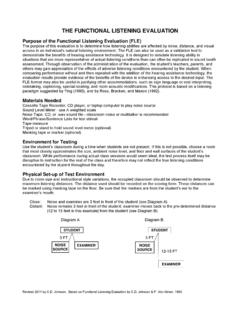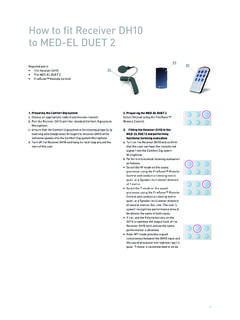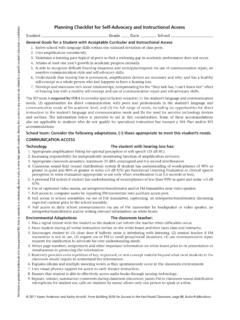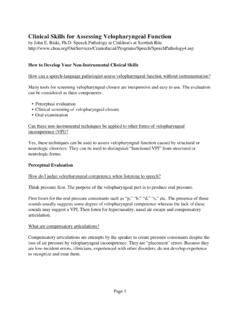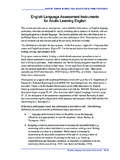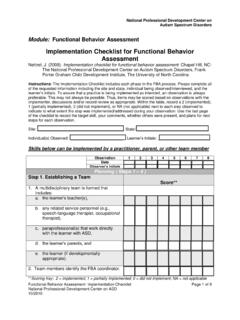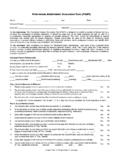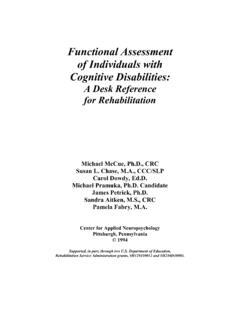Transcription of LISTENING SELF ASSESSMENT - adamsmithstudent.com
1 1 LISTENING self ASSESSMENT To help you start to be more aware of your LISTENING habits, complete the following LISTENING self - evaluation . Answer each question thoughtfully and after you have answered all the questions turn to page 3 to score your self ASSESSMENT . LISTENING Habit Almost Always Frequently Occasionally Almost Never Put an X in the appropriate column. Do you: 1. Tune out people who say something you don t agree with or don t want to hear? 2. Concentrate on what is being said even if you re not really interested? 3. Assume you know what the talker is going to say and stop LISTENING ? 4. Repeat in your own words what the talker has just said? 5. Listen to the other person s viewpoint, even if it differs from yours? 6. Learn something from each person you meet, even if it is ever so slight? 7. Find out what words mean when they are used in ways not familiar to you?
2 8. Form a rebuttal in your head while the speaker is talking? 9. Give the appearance of LISTENING when you aren t? 10. Daydream while the speaker is talking? 11. Listen to the whole message, what the talker is saying verbally and nonverbally? 2 LISTENING Habit Almost Always Frequently Occasionally Almost Never 12. Recognize that words don t mean exactly the same thing to different people? 13. Listen to only what you want to hear, blotting out the talker s whole message? 14. Look at the person who is talking? 15. Concentrate on the talker s meaning rather than how he or she looks? 16. Know which words and phrases you respond to emotionally? 17. Think about how the other person might react to what you say? 18. Plan the best time to say what you want to say? 19. Think about how the other person might react to what you say?
3 20. Consider the best way to make your communication (written, spoken, phone, bulletin board, memo, etc.) work? 21. Think about what kind of person you re talking to (worried, hostile, disinterested, rushed, shy, stubborn, impatient, etc.)? 22. Interrupt the talker while he or she is still talking? 23. Think, I assumed he or she would know that ? 3 LISTENING Habit Almost Always Frequently Occasionally Almost Never 24. Allow the talker to vent negative feelings toward you without becoming defensive? 25. Practice regularly to increase your LISTENING efficiency? 26. Take notes when necessary to help you to remember? 27. Hear noises without being distracted by them? 28. Listen to the talker without judging or criticising? 29. Restate instructions and messages to be sure you understand correctly? 30.
4 Paraphrase what you believe the talker is feeling? SCORE SHEET Circle the number that matches the time frame (almost always, frequently, etc.) you checked on each of the 30 items of the self - evaluation . Example: If you put an X under frequently for number 1, you would circle 2 in the frequently column. Then, add the circled scores in each of the columns. Now, write the scores of each column in the lines under each time frame category. 4 Almost Always Frequently Occasionally Almost Never 1. 1 2 3 4 2. 4 3 2 1 3. 1 2 3 4 4. 4 3 2 1 5. 4 3 2 1 6. 4 3 2 1 7. 4 3 2 1 8. 1 2 3 4 9. 1 2 3 4 10. 1 2 3 4 11. 4 3 2 1 12. 4 3 2 1 13. 1 2 3 4 14. 4 3 2 1 15. 4 3 2 1 16. 4 3 2 1 17. 4 3 2 1 18. 4 3 2 1 19. 4 3 2 1 20. 4 3 2 1 21. 1 2 3 4 22. 1 2 3 4 23. 1 2 3 4 24. 4 3 2 1 25. 4 3 2 1 26. 4 3 2 1 27. 4 3 2 1 28. 4 3 2 1 29. 4 3 2 1 30. 4 3 2 1 Totals 5 Total of items circled in each column: Almost Always Frequently Occasionally Almost Never Total + + + = Scoring: 110-120 Superior 99-109 Above Average 88-98 Average 77-87 Fair Below 77 You really need to work on improving your LISTENING skills!
5 The Students Association will be delivering Effective LISTENING Workshops in Semester Two, if you want to find out more information or book a place, contact Jo Mitchell, SA Coordinator. ACTION PLAN FOR LISTENING Action Plan: Reexamine your responses. What questions do you feel you want to modify and/or improve upon? Pick three to start working on. To get you started on modifying your behavior consider the following. In LISTENING , what I want to accomplish In college, what I want to accomplish through LISTENING In my role as class rep, what I want to accomplish through LISTENING
